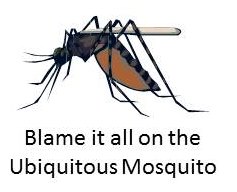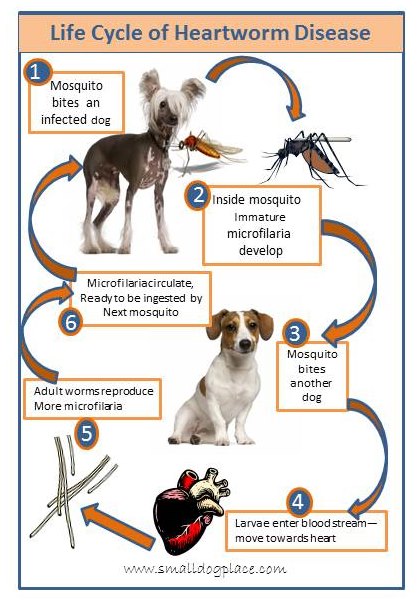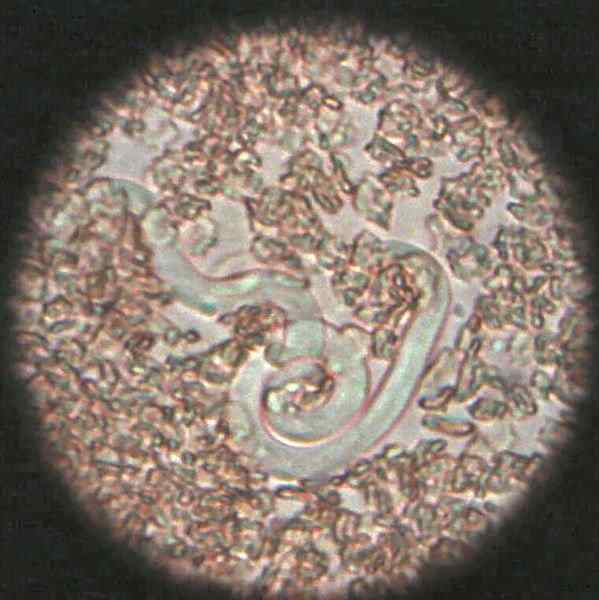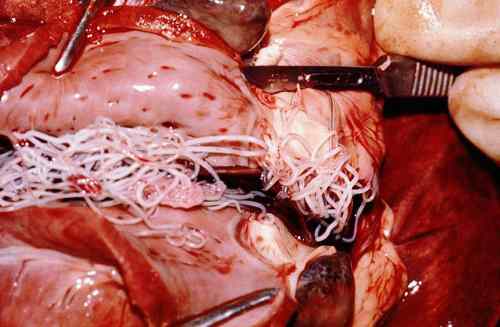Heartworm Disease in Small Dogs: Know the Facts
By Janice Jones |Last Updated 02-03-2020
Heartworm Disease is a serious and possibly fatal condition caused by a parasite called by its scientific name, Dirofilaria immitis. It gets its name because these parasites take up residence in the chambers of the heart and surrounding blood vessels.
Adult worms resemble long thin strains of spaghetti often upwards of 12 inches long and lodge in the lungs and heart, where they begin to reproduce.
Dogs, cats, ferrets can be affected. Other wild animal species are also susceptible including wolves, foxes, coyotes, and raccoons.
People can be bitten by infected mosquitoes, but the parasite cannot complete its life cycle in a person.
Table of Contents
Life Cycle of Heartworm Disease
The immature stage or larvae called microfilaria (pronounced micro-fill-air-ee-ay) enter the dog’s body through the bite of an affected mosquito, grow and mature and eventually migrate through tissue towards the dog’s heart.
In the heart and nearby pulmonary arteries, the sexually mature males and females mate producing more microfilaria. The adults do not attach to the heart or walls of the blood vessels, but rather feed on nutrients in the blood plasma.
The microfilaria then begins to circulate in the blood stream. At this point, another mosquito can bite the animal, taking a blood meal. The microfilaria stay in the mosquito becoming infected larva.
If that mosquito then bites another animal, whether it is a dog, cat or other, the disease will continue in that second animal. This entire life cycle takes approximately seven months. Adult worms, however, can remain in the dog’s heart for up to 7 years if untreated.
Incidence in the U.S.A.
Once thought to be a regional problem in the United States occurring in warmer states, it is now found in all 50 states. Still a major problem in the southern US, the highest incidents of the disease are found in dogs that have not been on preventative medicines.
According to American Heartworm Society, the highest incidence of heartworm disease is “observed within 150 miles of the Atlantic and Gulf coasts from the Gulf of Mexico to New Jersey and along the Mississippi River and its major tributaries.”
The American Heartworm Society estimates that over 1 million dogs are affected at any one time with the adult heartworm disease in the United States alone.
Symptoms of Heartworm Disease
Initially, ddogs that have the heartworm disease do not show symptoms. As the infection progresses and infestation increases the dog becomes lethargic, loses weight, has difficulty breathing, and coughs during exercise.
At this point, there may be a large number of adult worms living in the heart, lungs, and surround blood vessels. They restrict the blood flow which can lead to blood clots, liver or kidney failure.
Dogs with severe infections can die from the massive number of small developing larvae circulating in their system. Some estimates put the number of adult worms living within a dog as high as 250. Veterinarians will be able to hear unusual heart and lung sounds. Dogs that are not treated will eventually die.
Common Signs of Heartworm
- Coughing
- Difficulty Breathing,
- Sluggishness
- Some show no signs at all
Treatment
Heartworm disease is treated by using arsenic type drugs that poison the adult worms and help eliminate them from the dog’s system. It usually requires that the dog remain hospitalized so that he can be monitored for possible complications such as the adult worms breaking down and clogging up arteries as they are passed. Some veterinarians may suggest outpatient treatment.
Often the vet will recommend additional therapies depending on the age of the dog and the severity of the infestation. Once the treatment has begun, most of the adult worms will be killed within one to three months.
Once discharged from the hospital, the dog must be kept very quiet for the next several months. Any exercise has the potential to kill the dog due to a blockage of the large pulmonary vessels around the heart. The dog is then put on heartworm preventative.
Testing for Heartworm
Most veterinarians will recommend a yearly heartworm test, usually done at the same time as your annual physical exam. A general test called a “SNAP” test, is run in a few minutes right in the vet’s office.
If technicians are available for running the test, you should have the results before you leave the office, otherwise, the vet will notify you of results at a later time.
The test uses a very small amount of blood, and it is very accurate. Most people wonder why a yearly test is necessary especially if the dog is on heartworm preventative every month.
U.S. Food and Drug Administration requested that the American Heartworm Society make the recommendation that veterinarians do annual heartworm testing.
Most preventatives are very effective, but there is always room for human error, or dog error. For examine, a missed month or two, a dog not chewing up the medication or swallowing properly.
Preventatives
Preventing this disease is much easier than treating it and much safer for the dog. Prevention is also much more cost effective than treating the disease.
It used to be suggested that dogs receive heartworm prevention during the warm months of the year, and this could vary from state to state. Now, The American Heartworm Society recommends year-round prevention.
Giving the medication year round also assures that the dog will receive worming medication for common intestinal worms some of which can cause problems for people. If dogs are treated, there is much less chance that people can become infected with those intestinal worms.
To treat a full-blow case of heartworms can cost hundreds to thousands of dollars.
There are several products available on the market for heartworm prevention, including the option to give daily or monthly oral meds or get injections twice yearly. All heartworm medication is either dispensed or prescribed by a veterinarian.
Daily Treatments
Diethylcarbamazine is given daily and is effective against
heartworms only. This is not a common treatment nowa-days.
Monthly Treatments
Heartgard® & Heartgard® Plus, Iverhart® Plus & Iverhart MAX™ and Tri-Heart® Plus all have the generic, Ivermectin as the main ingredient and are given once per month and control heartworms as well as intestinal parasites such as roundworms, hookworms and whipworms. Ivermectin will kill immature heartworms in the dog the day it is given, but will not have an affect on new larvae that may be introduced into the dog the next day.
Sentinel is also given monthly and is effective against heartworms and fleas.
Revolution® made with Selamectin is applied topically to prevent heartworm disease. It is effective against fleas, heartworms, ear mites, sarcoptic mange and the American dog tick.
6 Month Treatment
A six-month injectable product called ProHeart 6® uses Moxidectin
Heartworm medication in the United States is obtained through prescription only. Be aware of rogue pharmacies that try to sell non prescription medications. These drugs may contain harmful substances or may provide no preventative ingredients at all.
Heartworm Disease: Personal Encounter & Advice
I hope your take away from this article is that you put your dog on heartworm preventative after getting him tested. As climate changes and development alters the landscape, it is likely we will see more mosquitoes and heartworm disease rather than less. Prevention, as they say is the best medicine.
As a vet tech in the 70s and 80s, we saw our fair share of heartworm problems. Back then, the only preventative was a pill that was given once a day. Now, we have much easier options and the medications have improved to help prevent other parasites. Giving a heartworm preventative is a win-win situation all round.
References
Weyenberg, K. Team Up Against Heartworm. The Team 2009. 6(4)10-12
For More information on Hearworm Disease in the U.S.A., visit
About Janice (author and voice behind this site)
Having lived with dogs and cats most of her life, Janice served as a veterinary technician for ten years in Maryland and twelve years as a Shih Tzu dog breeder in Ohio.
Her education includes undergraduate degrees in Psychology with a minor in biology, Early Childhood Education, and Nursing, and a master's in Mental Health Counseling.
She is a lifelong learner, a dog lover, and passionate about the welfare of animals. Her favorite breed for over 50 years has been the Shih Tzu, but she has also lived with Poodles, Maltese, Yorkshire Terriers, Beagles, English Bulldogs, Carin Terriers, and a Cocker Spaniel.
When not writing, reading, and researching dog-related topics, she likes to spend time with her eight Shih Tzu dogs, husband, and family, as well as knitting and crocheting. She is also the voice behind Miracle Shih Tzu and Smart-Knit-Crocheting
Does This Article Deserve Your Thumbs Up?
We always appreciate your support and encouragement. Your thumbs up means so much to us. Please like this article.
If you find this page or any page on Small Dog Place Helpful, or useful in anyway, I'd love it if you would click the small heart found on the bottom right of each page.
You can also share or bookmark this page -- just click on the:

Free Monthly Newsletter
Sign Up for Our Free Newsletter and get our Free Gift to You.
my E-book, The Top 10 Mistakes People Make When Choosing a Dog (and how to avoid them)





